Human Resource Management Report: Conflict, Hiring, and Policies
VerifiedAdded on 2022/08/20
|10
|1773
|12
Report
AI Summary
This report addresses key Human Resource Management (HRM) challenges within an organization experiencing growth, focusing on conflict resolution, employee selection, and policy development. It examines strategies for resolving workplace conflicts arising from diverse employee backgrounds and opinions, emphasizing the role of leaders in mediating and finding solutions. The report then delves into effective employee selection and placement strategies, differentiating between internal promotion for a Chief Information Officer (CIO) and external hiring for administrative clerks. It highlights the importance of developing robust hiring strategies, including job descriptions, sourcing candidates, and evaluating their suitability. Furthermore, the report outlines the significance of HR policies, covering workplace regulations, hiring procedures, and their alignment with organizational goals. The report emphasizes the HR Director's role in creating and implementing these policies to ensure effective employee management and contribute to the organization's overall success. Finally, the report concludes by reiterating the importance of strategic HRM practices in achieving organizational objectives.

Secure Best Marks with AI Grader
Need help grading? Try our AI Grader for instant feedback on your assignments.
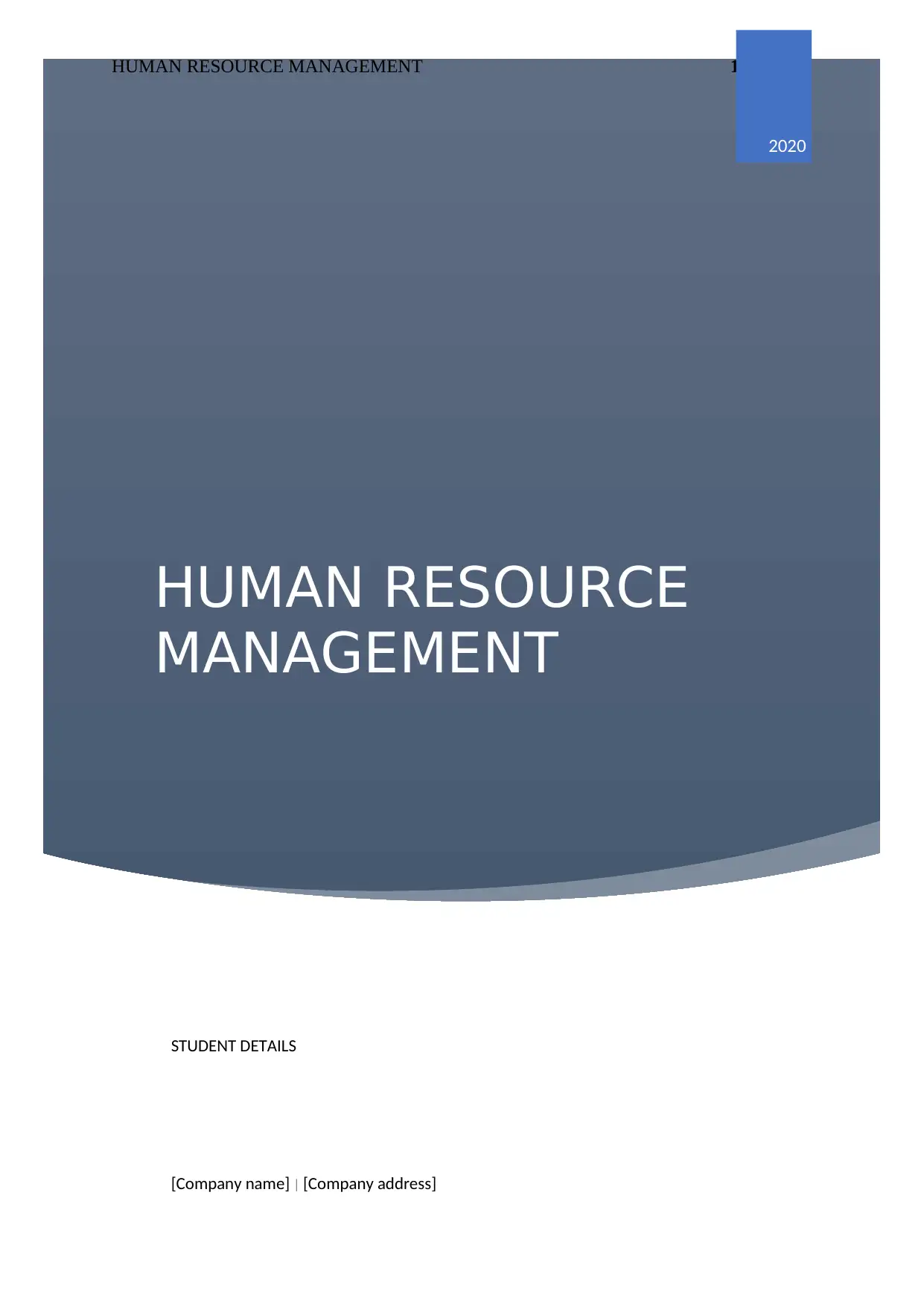
HUMAN RESOURCE
MANAGEMENT
HUMAN RESOURCE MANAGEMENT 1 | P a g e
2020
STUDENT DETAILS
[Company name] | [Company address]
MANAGEMENT
HUMAN RESOURCE MANAGEMENT 1 | P a g e
2020
STUDENT DETAILS
[Company name] | [Company address]
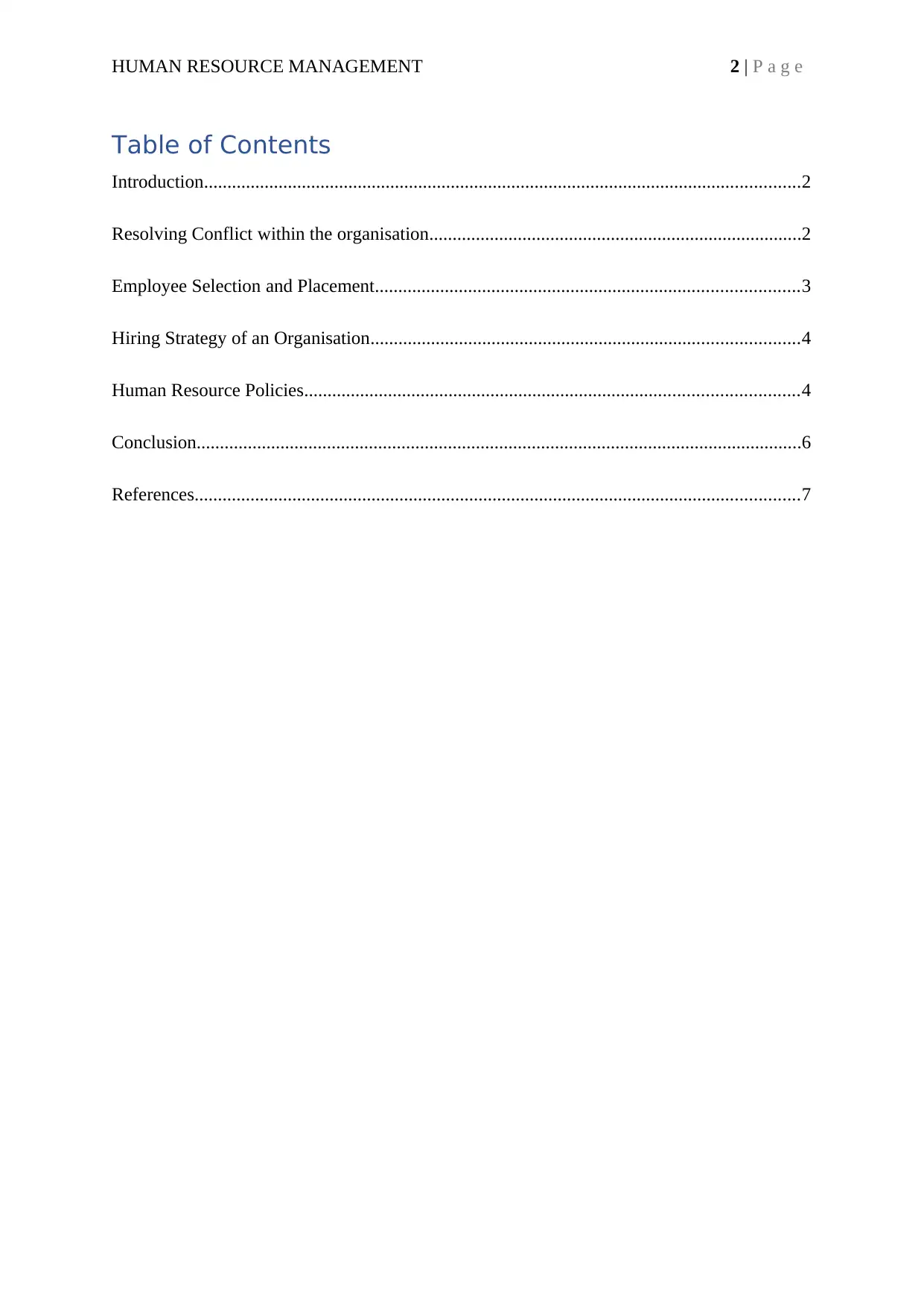
HUMAN RESOURCE MANAGEMENT 2 | P a g e
Table of Contents
Introduction................................................................................................................................2
Resolving Conflict within the organisation................................................................................2
Employee Selection and Placement...........................................................................................3
Hiring Strategy of an Organisation............................................................................................4
Human Resource Policies..........................................................................................................4
Conclusion..................................................................................................................................6
References..................................................................................................................................7
Table of Contents
Introduction................................................................................................................................2
Resolving Conflict within the organisation................................................................................2
Employee Selection and Placement...........................................................................................3
Hiring Strategy of an Organisation............................................................................................4
Human Resource Policies..........................................................................................................4
Conclusion..................................................................................................................................6
References..................................................................................................................................7
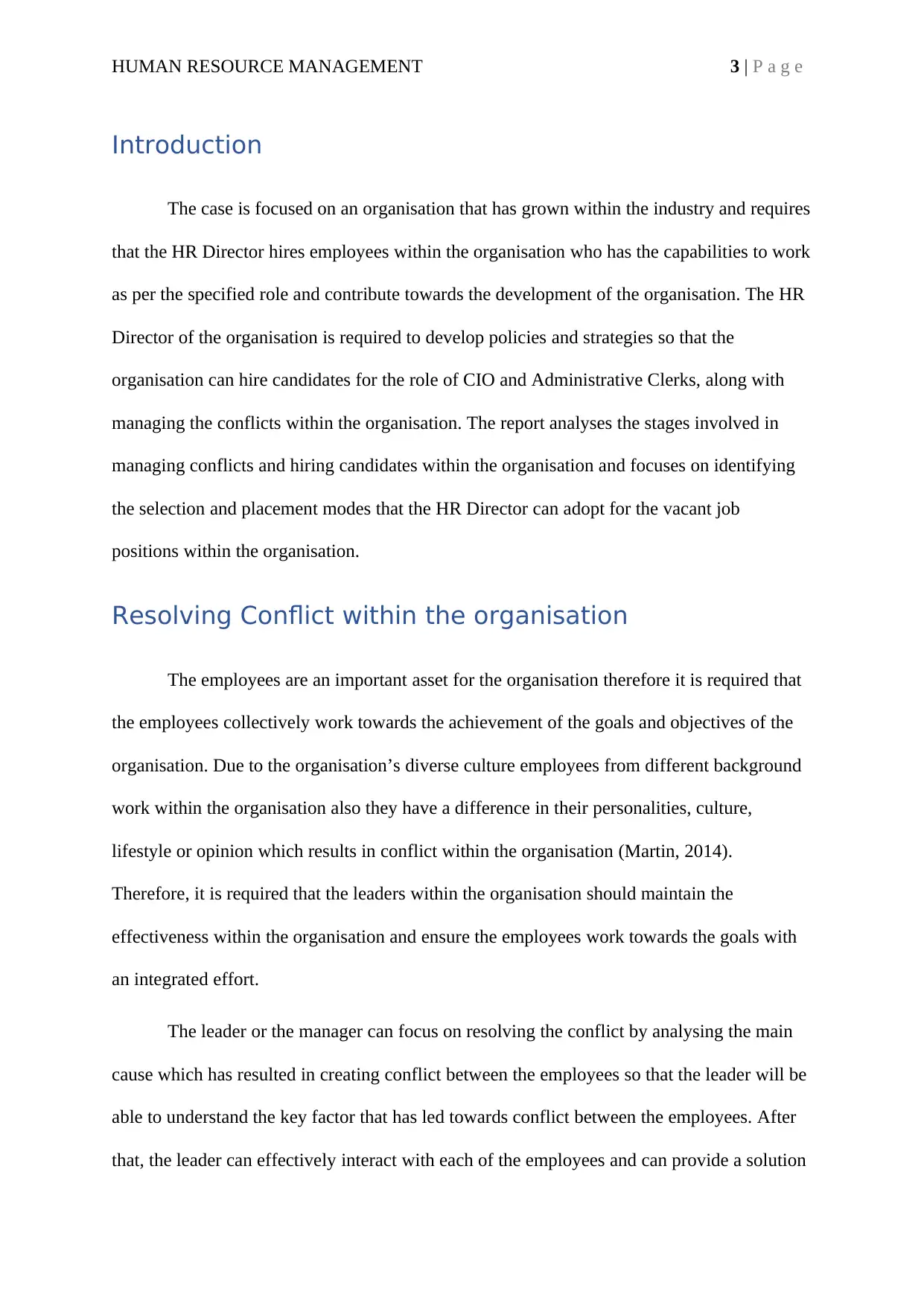
HUMAN RESOURCE MANAGEMENT 3 | P a g e
Introduction
The case is focused on an organisation that has grown within the industry and requires
that the HR Director hires employees within the organisation who has the capabilities to work
as per the specified role and contribute towards the development of the organisation. The HR
Director of the organisation is required to develop policies and strategies so that the
organisation can hire candidates for the role of CIO and Administrative Clerks, along with
managing the conflicts within the organisation. The report analyses the stages involved in
managing conflicts and hiring candidates within the organisation and focuses on identifying
the selection and placement modes that the HR Director can adopt for the vacant job
positions within the organisation.
Resolving Conflict within the organisation
The employees are an important asset for the organisation therefore it is required that
the employees collectively work towards the achievement of the goals and objectives of the
organisation. Due to the organisation’s diverse culture employees from different background
work within the organisation also they have a difference in their personalities, culture,
lifestyle or opinion which results in conflict within the organisation (Martin, 2014).
Therefore, it is required that the leaders within the organisation should maintain the
effectiveness within the organisation and ensure the employees work towards the goals with
an integrated effort.
The leader or the manager can focus on resolving the conflict by analysing the main
cause which has resulted in creating conflict between the employees so that the leader will be
able to understand the key factor that has led towards conflict between the employees. After
that, the leader can effectively interact with each of the employees and can provide a solution
Introduction
The case is focused on an organisation that has grown within the industry and requires
that the HR Director hires employees within the organisation who has the capabilities to work
as per the specified role and contribute towards the development of the organisation. The HR
Director of the organisation is required to develop policies and strategies so that the
organisation can hire candidates for the role of CIO and Administrative Clerks, along with
managing the conflicts within the organisation. The report analyses the stages involved in
managing conflicts and hiring candidates within the organisation and focuses on identifying
the selection and placement modes that the HR Director can adopt for the vacant job
positions within the organisation.
Resolving Conflict within the organisation
The employees are an important asset for the organisation therefore it is required that
the employees collectively work towards the achievement of the goals and objectives of the
organisation. Due to the organisation’s diverse culture employees from different background
work within the organisation also they have a difference in their personalities, culture,
lifestyle or opinion which results in conflict within the organisation (Martin, 2014).
Therefore, it is required that the leaders within the organisation should maintain the
effectiveness within the organisation and ensure the employees work towards the goals with
an integrated effort.
The leader or the manager can focus on resolving the conflict by analysing the main
cause which has resulted in creating conflict between the employees so that the leader will be
able to understand the key factor that has led towards conflict between the employees. After
that, the leader can effectively interact with each of the employees and can provide a solution
Secure Best Marks with AI Grader
Need help grading? Try our AI Grader for instant feedback on your assignments.
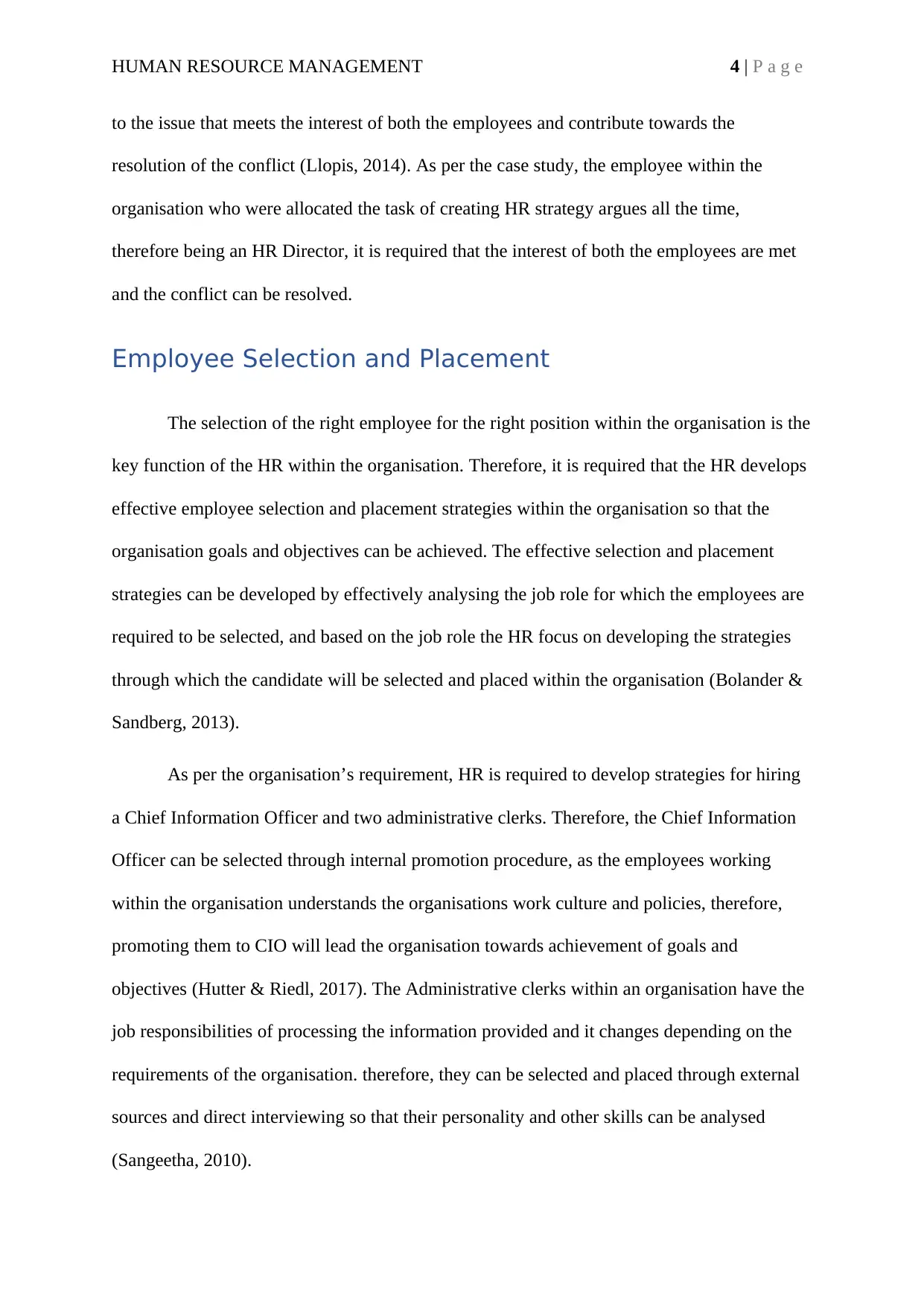
HUMAN RESOURCE MANAGEMENT 4 | P a g e
to the issue that meets the interest of both the employees and contribute towards the
resolution of the conflict (Llopis, 2014). As per the case study, the employee within the
organisation who were allocated the task of creating HR strategy argues all the time,
therefore being an HR Director, it is required that the interest of both the employees are met
and the conflict can be resolved.
Employee Selection and Placement
The selection of the right employee for the right position within the organisation is the
key function of the HR within the organisation. Therefore, it is required that the HR develops
effective employee selection and placement strategies within the organisation so that the
organisation goals and objectives can be achieved. The effective selection and placement
strategies can be developed by effectively analysing the job role for which the employees are
required to be selected, and based on the job role the HR focus on developing the strategies
through which the candidate will be selected and placed within the organisation (Bolander &
Sandberg, 2013).
As per the organisation’s requirement, HR is required to develop strategies for hiring
a Chief Information Officer and two administrative clerks. Therefore, the Chief Information
Officer can be selected through internal promotion procedure, as the employees working
within the organisation understands the organisations work culture and policies, therefore,
promoting them to CIO will lead the organisation towards achievement of goals and
objectives (Hutter & Riedl, 2017). The Administrative clerks within an organisation have the
job responsibilities of processing the information provided and it changes depending on the
requirements of the organisation. therefore, they can be selected and placed through external
sources and direct interviewing so that their personality and other skills can be analysed
(Sangeetha, 2010).
to the issue that meets the interest of both the employees and contribute towards the
resolution of the conflict (Llopis, 2014). As per the case study, the employee within the
organisation who were allocated the task of creating HR strategy argues all the time,
therefore being an HR Director, it is required that the interest of both the employees are met
and the conflict can be resolved.
Employee Selection and Placement
The selection of the right employee for the right position within the organisation is the
key function of the HR within the organisation. Therefore, it is required that the HR develops
effective employee selection and placement strategies within the organisation so that the
organisation goals and objectives can be achieved. The effective selection and placement
strategies can be developed by effectively analysing the job role for which the employees are
required to be selected, and based on the job role the HR focus on developing the strategies
through which the candidate will be selected and placed within the organisation (Bolander &
Sandberg, 2013).
As per the organisation’s requirement, HR is required to develop strategies for hiring
a Chief Information Officer and two administrative clerks. Therefore, the Chief Information
Officer can be selected through internal promotion procedure, as the employees working
within the organisation understands the organisations work culture and policies, therefore,
promoting them to CIO will lead the organisation towards achievement of goals and
objectives (Hutter & Riedl, 2017). The Administrative clerks within an organisation have the
job responsibilities of processing the information provided and it changes depending on the
requirements of the organisation. therefore, they can be selected and placed through external
sources and direct interviewing so that their personality and other skills can be analysed
(Sangeetha, 2010).
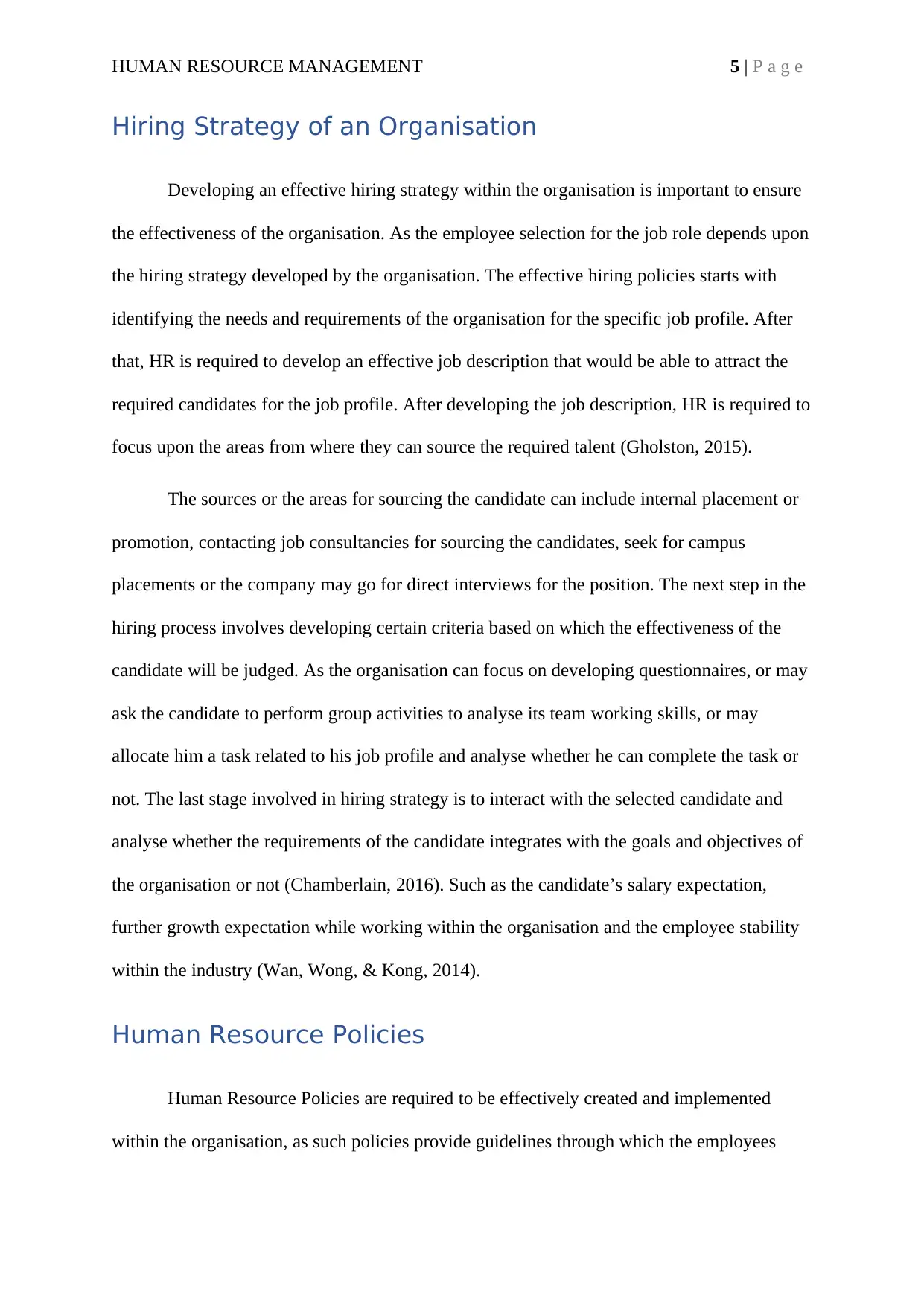
HUMAN RESOURCE MANAGEMENT 5 | P a g e
Hiring Strategy of an Organisation
Developing an effective hiring strategy within the organisation is important to ensure
the effectiveness of the organisation. As the employee selection for the job role depends upon
the hiring strategy developed by the organisation. The effective hiring policies starts with
identifying the needs and requirements of the organisation for the specific job profile. After
that, HR is required to develop an effective job description that would be able to attract the
required candidates for the job profile. After developing the job description, HR is required to
focus upon the areas from where they can source the required talent (Gholston, 2015).
The sources or the areas for sourcing the candidate can include internal placement or
promotion, contacting job consultancies for sourcing the candidates, seek for campus
placements or the company may go for direct interviews for the position. The next step in the
hiring process involves developing certain criteria based on which the effectiveness of the
candidate will be judged. As the organisation can focus on developing questionnaires, or may
ask the candidate to perform group activities to analyse its team working skills, or may
allocate him a task related to his job profile and analyse whether he can complete the task or
not. The last stage involved in hiring strategy is to interact with the selected candidate and
analyse whether the requirements of the candidate integrates with the goals and objectives of
the organisation or not (Chamberlain, 2016). Such as the candidate’s salary expectation,
further growth expectation while working within the organisation and the employee stability
within the industry (Wan, Wong, & Kong, 2014).
Human Resource Policies
Human Resource Policies are required to be effectively created and implemented
within the organisation, as such policies provide guidelines through which the employees
Hiring Strategy of an Organisation
Developing an effective hiring strategy within the organisation is important to ensure
the effectiveness of the organisation. As the employee selection for the job role depends upon
the hiring strategy developed by the organisation. The effective hiring policies starts with
identifying the needs and requirements of the organisation for the specific job profile. After
that, HR is required to develop an effective job description that would be able to attract the
required candidates for the job profile. After developing the job description, HR is required to
focus upon the areas from where they can source the required talent (Gholston, 2015).
The sources or the areas for sourcing the candidate can include internal placement or
promotion, contacting job consultancies for sourcing the candidates, seek for campus
placements or the company may go for direct interviews for the position. The next step in the
hiring process involves developing certain criteria based on which the effectiveness of the
candidate will be judged. As the organisation can focus on developing questionnaires, or may
ask the candidate to perform group activities to analyse its team working skills, or may
allocate him a task related to his job profile and analyse whether he can complete the task or
not. The last stage involved in hiring strategy is to interact with the selected candidate and
analyse whether the requirements of the candidate integrates with the goals and objectives of
the organisation or not (Chamberlain, 2016). Such as the candidate’s salary expectation,
further growth expectation while working within the organisation and the employee stability
within the industry (Wan, Wong, & Kong, 2014).
Human Resource Policies
Human Resource Policies are required to be effectively created and implemented
within the organisation, as such policies provide guidelines through which the employees
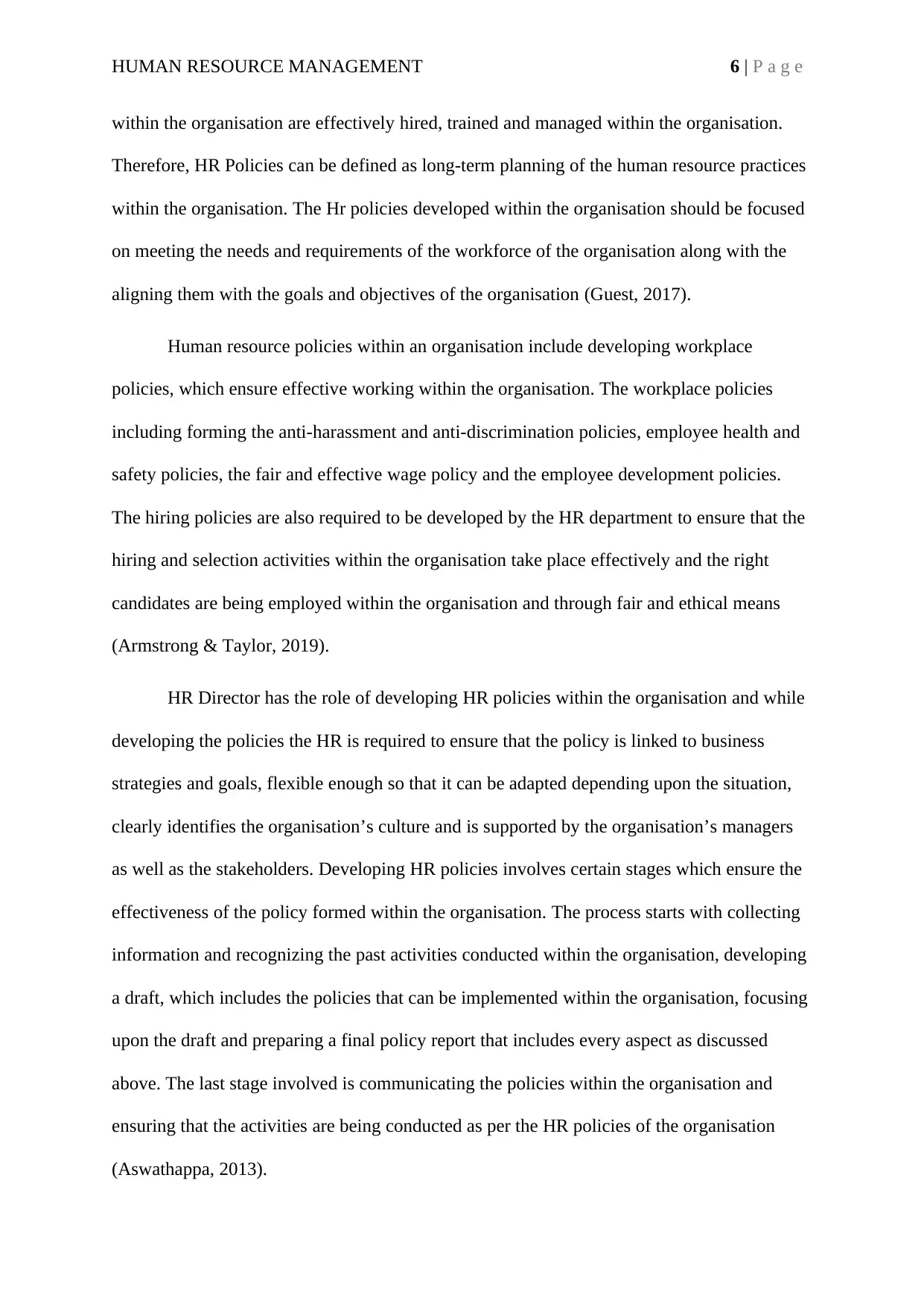
HUMAN RESOURCE MANAGEMENT 6 | P a g e
within the organisation are effectively hired, trained and managed within the organisation.
Therefore, HR Policies can be defined as long-term planning of the human resource practices
within the organisation. The Hr policies developed within the organisation should be focused
on meeting the needs and requirements of the workforce of the organisation along with the
aligning them with the goals and objectives of the organisation (Guest, 2017).
Human resource policies within an organisation include developing workplace
policies, which ensure effective working within the organisation. The workplace policies
including forming the anti-harassment and anti-discrimination policies, employee health and
safety policies, the fair and effective wage policy and the employee development policies.
The hiring policies are also required to be developed by the HR department to ensure that the
hiring and selection activities within the organisation take place effectively and the right
candidates are being employed within the organisation and through fair and ethical means
(Armstrong & Taylor, 2019).
HR Director has the role of developing HR policies within the organisation and while
developing the policies the HR is required to ensure that the policy is linked to business
strategies and goals, flexible enough so that it can be adapted depending upon the situation,
clearly identifies the organisation’s culture and is supported by the organisation’s managers
as well as the stakeholders. Developing HR policies involves certain stages which ensure the
effectiveness of the policy formed within the organisation. The process starts with collecting
information and recognizing the past activities conducted within the organisation, developing
a draft, which includes the policies that can be implemented within the organisation, focusing
upon the draft and preparing a final policy report that includes every aspect as discussed
above. The last stage involved is communicating the policies within the organisation and
ensuring that the activities are being conducted as per the HR policies of the organisation
(Aswathappa, 2013).
within the organisation are effectively hired, trained and managed within the organisation.
Therefore, HR Policies can be defined as long-term planning of the human resource practices
within the organisation. The Hr policies developed within the organisation should be focused
on meeting the needs and requirements of the workforce of the organisation along with the
aligning them with the goals and objectives of the organisation (Guest, 2017).
Human resource policies within an organisation include developing workplace
policies, which ensure effective working within the organisation. The workplace policies
including forming the anti-harassment and anti-discrimination policies, employee health and
safety policies, the fair and effective wage policy and the employee development policies.
The hiring policies are also required to be developed by the HR department to ensure that the
hiring and selection activities within the organisation take place effectively and the right
candidates are being employed within the organisation and through fair and ethical means
(Armstrong & Taylor, 2019).
HR Director has the role of developing HR policies within the organisation and while
developing the policies the HR is required to ensure that the policy is linked to business
strategies and goals, flexible enough so that it can be adapted depending upon the situation,
clearly identifies the organisation’s culture and is supported by the organisation’s managers
as well as the stakeholders. Developing HR policies involves certain stages which ensure the
effectiveness of the policy formed within the organisation. The process starts with collecting
information and recognizing the past activities conducted within the organisation, developing
a draft, which includes the policies that can be implemented within the organisation, focusing
upon the draft and preparing a final policy report that includes every aspect as discussed
above. The last stage involved is communicating the policies within the organisation and
ensuring that the activities are being conducted as per the HR policies of the organisation
(Aswathappa, 2013).
Paraphrase This Document
Need a fresh take? Get an instant paraphrase of this document with our AI Paraphraser
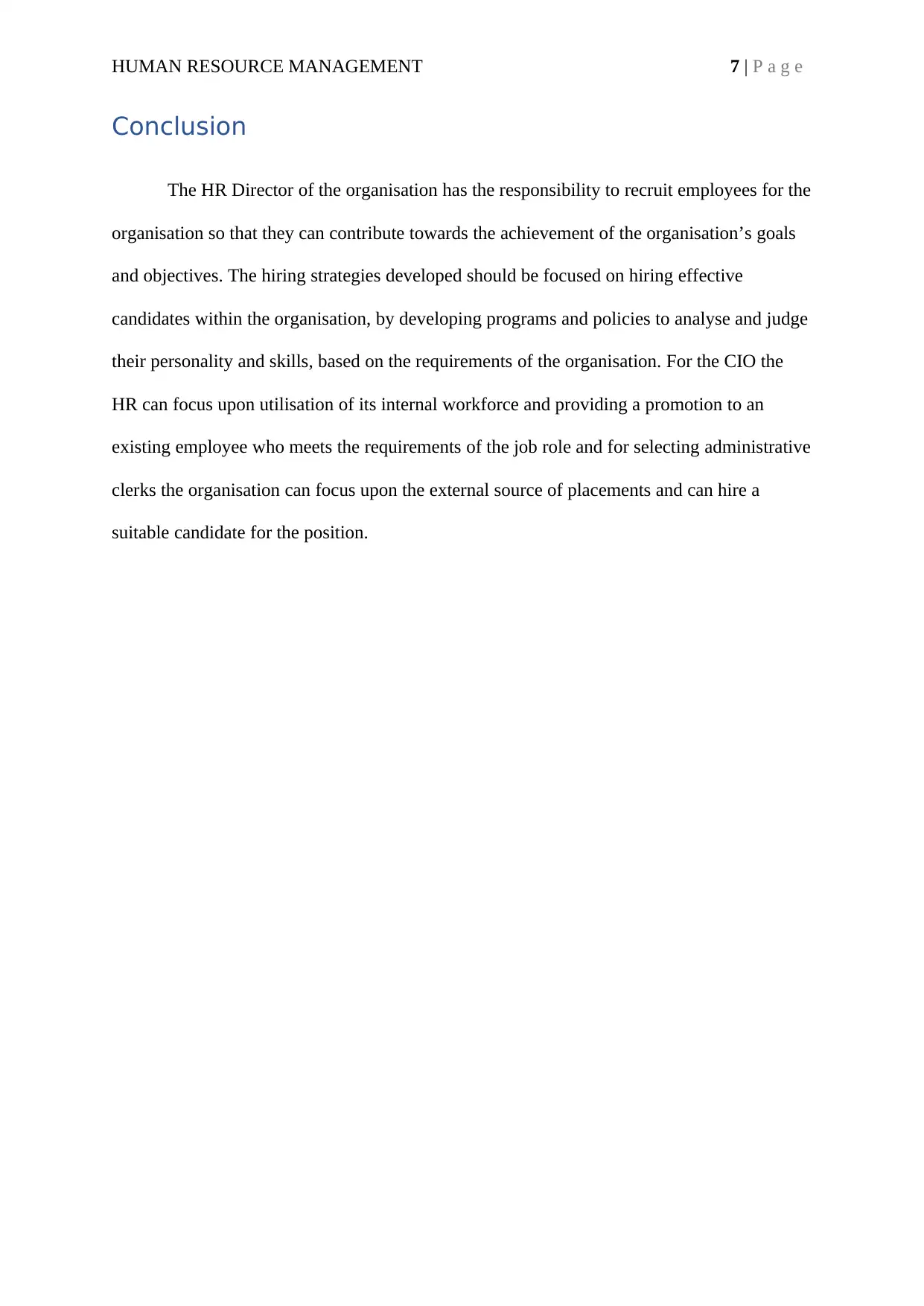
HUMAN RESOURCE MANAGEMENT 7 | P a g e
Conclusion
The HR Director of the organisation has the responsibility to recruit employees for the
organisation so that they can contribute towards the achievement of the organisation’s goals
and objectives. The hiring strategies developed should be focused on hiring effective
candidates within the organisation, by developing programs and policies to analyse and judge
their personality and skills, based on the requirements of the organisation. For the CIO the
HR can focus upon utilisation of its internal workforce and providing a promotion to an
existing employee who meets the requirements of the job role and for selecting administrative
clerks the organisation can focus upon the external source of placements and can hire a
suitable candidate for the position.
Conclusion
The HR Director of the organisation has the responsibility to recruit employees for the
organisation so that they can contribute towards the achievement of the organisation’s goals
and objectives. The hiring strategies developed should be focused on hiring effective
candidates within the organisation, by developing programs and policies to analyse and judge
their personality and skills, based on the requirements of the organisation. For the CIO the
HR can focus upon utilisation of its internal workforce and providing a promotion to an
existing employee who meets the requirements of the job role and for selecting administrative
clerks the organisation can focus upon the external source of placements and can hire a
suitable candidate for the position.
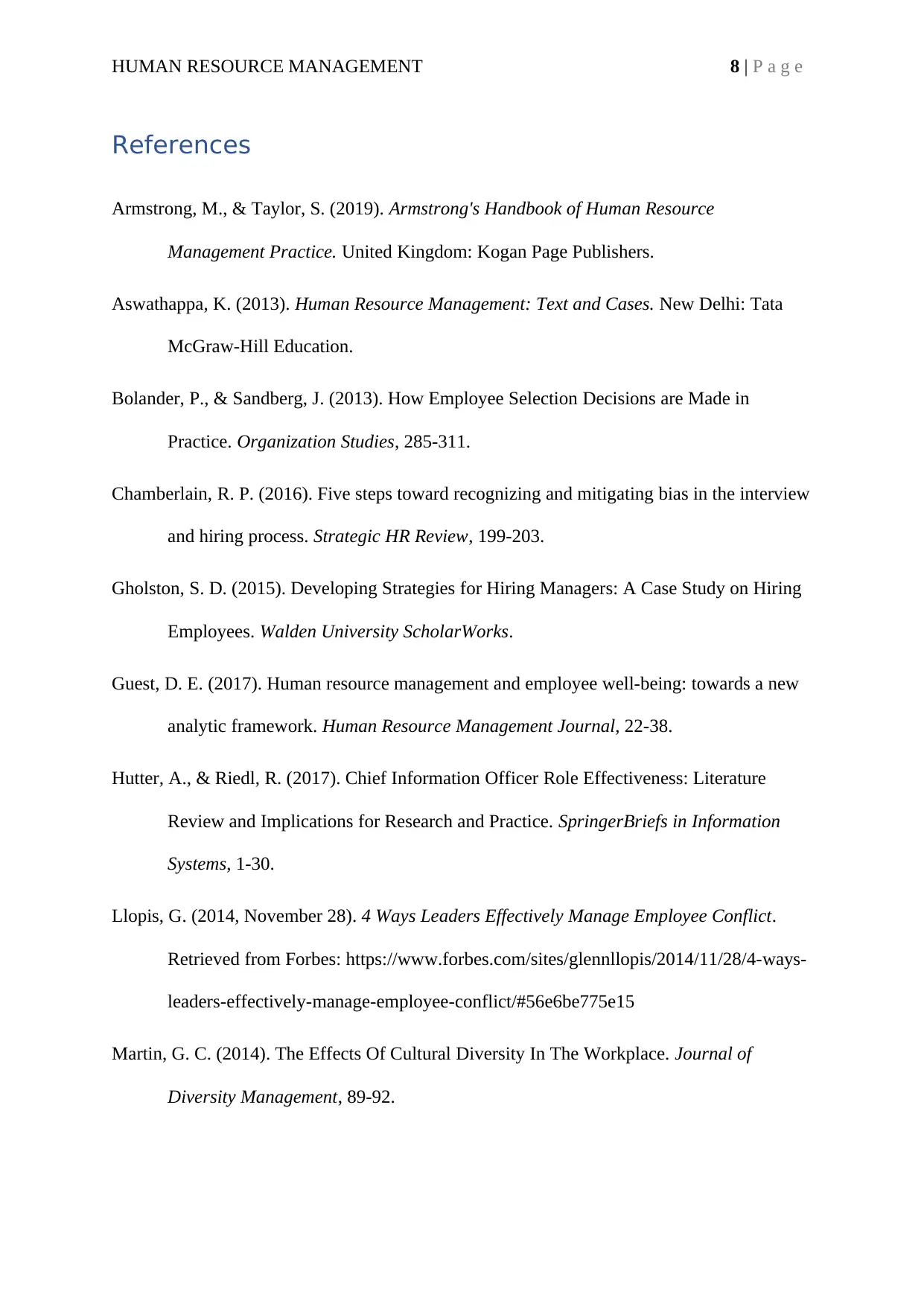
HUMAN RESOURCE MANAGEMENT 8 | P a g e
References
Armstrong, M., & Taylor, S. (2019). Armstrong's Handbook of Human Resource
Management Practice. United Kingdom: Kogan Page Publishers.
Aswathappa, K. (2013). Human Resource Management: Text and Cases. New Delhi: Tata
McGraw-Hill Education.
Bolander, P., & Sandberg, J. (2013). How Employee Selection Decisions are Made in
Practice. Organization Studies, 285-311.
Chamberlain, R. P. (2016). Five steps toward recognizing and mitigating bias in the interview
and hiring process. Strategic HR Review, 199-203.
Gholston, S. D. (2015). Developing Strategies for Hiring Managers: A Case Study on Hiring
Employees. Walden University ScholarWorks.
Guest, D. E. (2017). Human resource management and employee well‐being: towards a new
analytic framework. Human Resource Management Journal, 22-38.
Hutter, A., & Riedl, R. (2017). Chief Information Officer Role Effectiveness: Literature
Review and Implications for Research and Practice. SpringerBriefs in Information
Systems, 1-30.
Llopis, G. (2014, November 28). 4 Ways Leaders Effectively Manage Employee Conflict.
Retrieved from Forbes: https://www.forbes.com/sites/glennllopis/2014/11/28/4-ways-
leaders-effectively-manage-employee-conflict/#56e6be775e15
Martin, G. C. (2014). The Effects Of Cultural Diversity In The Workplace. Journal of
Diversity Management, 89-92.
References
Armstrong, M., & Taylor, S. (2019). Armstrong's Handbook of Human Resource
Management Practice. United Kingdom: Kogan Page Publishers.
Aswathappa, K. (2013). Human Resource Management: Text and Cases. New Delhi: Tata
McGraw-Hill Education.
Bolander, P., & Sandberg, J. (2013). How Employee Selection Decisions are Made in
Practice. Organization Studies, 285-311.
Chamberlain, R. P. (2016). Five steps toward recognizing and mitigating bias in the interview
and hiring process. Strategic HR Review, 199-203.
Gholston, S. D. (2015). Developing Strategies for Hiring Managers: A Case Study on Hiring
Employees. Walden University ScholarWorks.
Guest, D. E. (2017). Human resource management and employee well‐being: towards a new
analytic framework. Human Resource Management Journal, 22-38.
Hutter, A., & Riedl, R. (2017). Chief Information Officer Role Effectiveness: Literature
Review and Implications for Research and Practice. SpringerBriefs in Information
Systems, 1-30.
Llopis, G. (2014, November 28). 4 Ways Leaders Effectively Manage Employee Conflict.
Retrieved from Forbes: https://www.forbes.com/sites/glennllopis/2014/11/28/4-ways-
leaders-effectively-manage-employee-conflict/#56e6be775e15
Martin, G. C. (2014). The Effects Of Cultural Diversity In The Workplace. Journal of
Diversity Management, 89-92.
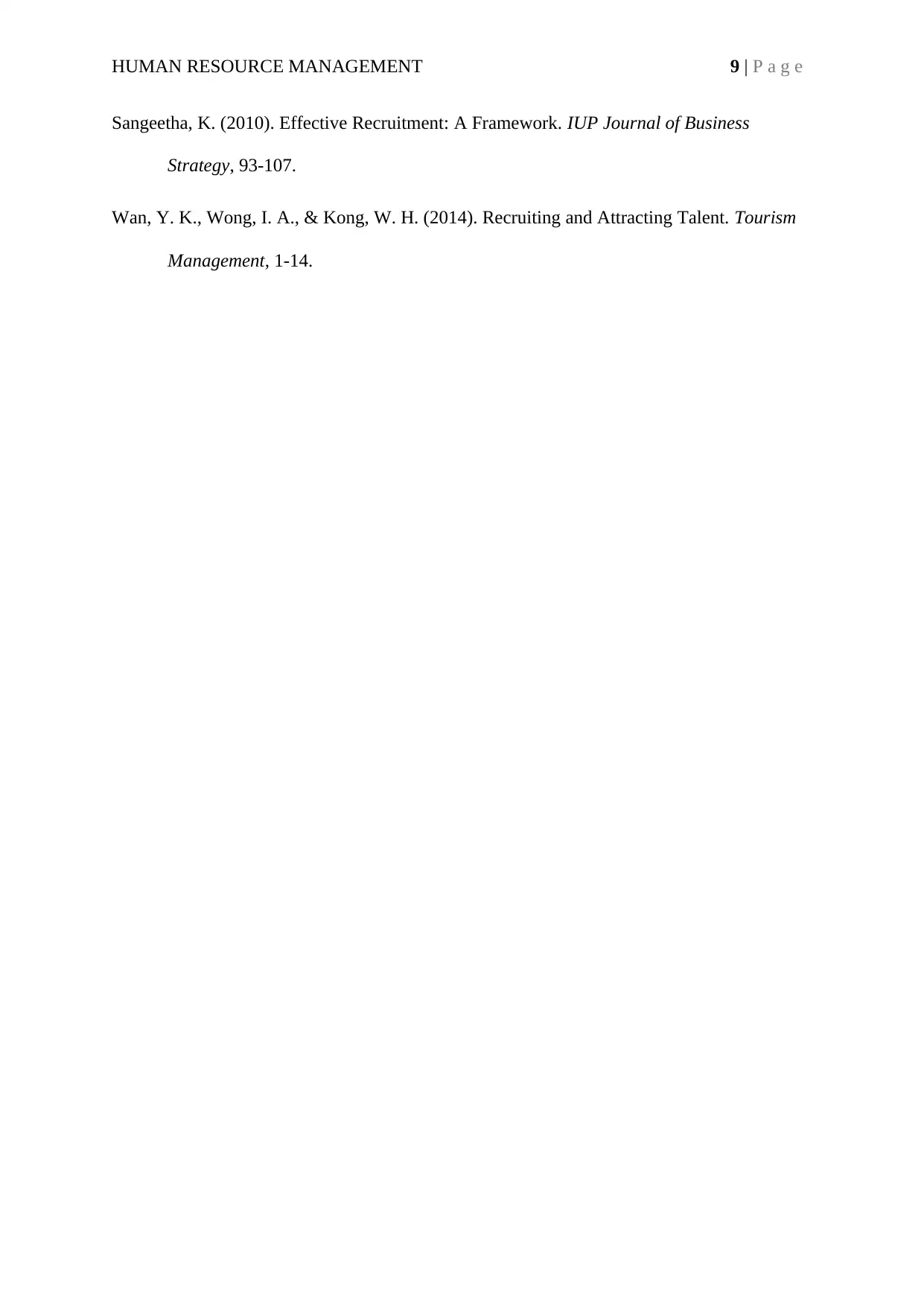
HUMAN RESOURCE MANAGEMENT 9 | P a g e
Sangeetha, K. (2010). Effective Recruitment: A Framework. IUP Journal of Business
Strategy, 93-107.
Wan, Y. K., Wong, I. A., & Kong, W. H. (2014). Recruiting and Attracting Talent. Tourism
Management, 1-14.
Sangeetha, K. (2010). Effective Recruitment: A Framework. IUP Journal of Business
Strategy, 93-107.
Wan, Y. K., Wong, I. A., & Kong, W. H. (2014). Recruiting and Attracting Talent. Tourism
Management, 1-14.
1 out of 10
Related Documents
Your All-in-One AI-Powered Toolkit for Academic Success.
+13062052269
info@desklib.com
Available 24*7 on WhatsApp / Email
![[object Object]](/_next/static/media/star-bottom.7253800d.svg)
Unlock your academic potential
© 2024 | Zucol Services PVT LTD | All rights reserved.




